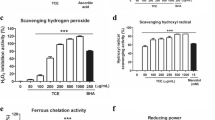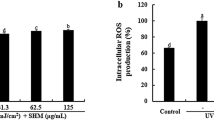Abstract
The purpose of this study was to evaluate the antioxidant effect of rosmarinic acid on the cultured human skin melanoma cells injured by reactive oxygen species. The cytotoxicity and antioxidant effect were analyzed by XTT assay for cell adhesion activity, DPPH-radical scavenging activity, lactate dehydrogenase (LDH) activity after treated of cells with or without hydrogen peroxide (H2O2) for 1–10 h. H2O2 decreased the cell adhesion activity in cultured human melanoma cells in a dose- and time-dependent manner after cells were treated with 20–110 ώM of H2O2 for 5–7 h. IC50 values of H2O2 by XTT assay were 90 ώM, respectively. H2O2 increased LDH activity dose dependently. LDH50 was determined at 60 ώM H2O2 after treatment of cells with 50–90 ώM H2O2 for 8 h. Rosmarinic acid increases cell adhesion activity, DPPH-radical scavenging and decreases LDH activity. The treatment of the cells with H2O2 shows highly toxic effects on cultured human skin melanoma cells. Rosmarinic acid increases cell adhesion activity, DPPH-radical scavenging activity and decreases LDH activity in the cells treated with H2O2. It is considered that rosmarinic acid shows antioxidant effect on ROS such as H2O2.
Similar content being viewed by others
Abbreviations
- LDH:
-
lactate dehydrogenase
- MCV:
-
midpoint cytotoxicity value
- RMA:
-
rosmarinic acid
- RNS:
-
reactive nitrogen species
- ROS:
-
reactive oxygen species
References
Andrade PB, Oliverira BM, Scabra RM, Ferreira MA, Ferreres F, and Garcia-viguera C (2001) Analysis of phenolic compounds in Spanish Albrarino and Portuguese Alvarinho and loureiro wines by capillary zone electrophoresis and high-performance liquid chromatofraphy. Electrophoresis 22, 1568–1572.
Borenfreund E, Babichi H, and Martin-Alcuacil N (1988) Comparisons of two in vitro cytotoxicity assay-the neutral red(NR) and tetrazolium MTT test. Toxicol In Vitro 2, 1–6.
Brune B, Zhou J, and Von Knethen (2003) A nitric oxide, oxidative stress, and apoptosis. Kidney Int Suppl 84, 22–24.
Chen S, Fu Y, and Wu R (1999) Effects of rosmarinic acid on free radical production and lysosomal enzyme release from rat peritoneal neutrophils. Acta Pharmacol Sin 34, 881–885.
Delanty N and Dichter MA (1998) Oxidative injury in the nervous system. Acta Neurol Scand 98, 145–153.
Difazio MC, Hollingsworth Z, Young AB, and Penny JB (1992) Glutamate receptors in the substentia nigra of Parkinson’s disease brain. Neurology 42, 402–408.
Duthie GG (1999) Parsley, polyphenols and nutritional antioxidants. Br J Nutr 81, 425–626.
Heilmann J, Calis I, Kirmizibekmez H, Schuhly W, Harput S, and Sticher O (2000) Radical scavenger activity of phenylethanoid glycosides in FMLP stimulated human polymorphonuclear leukocytes: structure-activity relationships. Planta Med 66, 746–748.
Hirota A, Taki S, Kawaii S, Yano M, and Abe N (2000) 1-Diphenyl-2-picrylhydrazyl radical-scavenging compounds from soybean miso and antiproliferative acitvity of isoflavones from soybean miso toward the cancer cell lines. Biosci Biotechnol Biochem 64, 1038–1040.
Hruszkewycz AM (1998) Evidence for mitochondrial DNA damage by lipid peroxidation. Biochem Bioph Res Comm 153, 191–197.
Inoue M, Suzuki R, Sakaguchi N, Li Z, Takeda T, Ogihara Y, Jiang BY, and Chen Y (1995) Selective induction of cell death in cancer cells by gallic acid. Biol Pharm Bull 18, 1526–1530.
Kang YH, Park YK, Oh SR, and Moon KD (1995) Studies on the physiological functionality of pine needle and mugort extracts. Korean J Food Sci Technol 27, 978–984.
Kim JB, Whang YS, Kim JB, Park ND, and Cho KJ (1999) Isolation, identification, and activity of rosmarinic acid, a potent antioxidant extracted from Korean Agastache rugosa. J Korean Agric Chem Soc 42, 262–266.
Kim MS, Jin BK, Chun SW, Lee MY, Lee SH, Kim JH, and Park BR (1997) Role of verstibulo-cerebellar N-mehtyl-D-sapartate receptors for behavioral recovery following unilateral labyrinthectomy in rats. Neurosci Lett 222, 171–174.
Kim YS and Kim SU (1991) Oilgodendroglial cell death induced by oxygen radicals and its protection by catalase. J Neurosci Res 29, 100–106.
Mattson MP, Cheng B, and Sminth-Swintosky VL (1993) Mechanisms of neurotrophic factor protection against calcium-and free radical mediated excitotoxic injury: Implications for treating neurogenerative disorders. J Exp Neurol 124, 89–95.
Mosmann T (1983) Rapid colorimetric assay for cellular growth and survival Application to proliferation and cytotoxicity assays. J Immunol Methods 65, 55–63.
Osakabe N, Yasuda A, Natsume M, Sanbongi C, Kato Y, Osawa T, and Yoshikawa T (2002) Rosmarinic acid, a major polyphenolic component of Perilla frutescens, reduces lipopolysaccharide (LPS)-induced liver injury in d-galactosamine (d-GalN)-sensitized mice. Free Radical Bio Med 33, 798–806.
Pannala AS, Ricw-Evans CA, Halliwell B, and Singh S (1997) Inhibition of peroxvnitrite-mediatrd tyrosine nitration by catechin polyphenols. Biochem Bioph Res Comm 232, 164–170.
Park JI, Lee KS, Park MJ, Lee SH, and Kang SJ (1999) Isolation and quantitative determination of tanshinone IlA from the rhizomes of Salvia miltiorrhiza Bunge. Korean J Pharmacogn 30, 158–162.
Saunders RD, Dugan LL, Demediuk P, Means ED, Harrocks LA, and Anderson DK (1987) Effects of methyl prednisolone and the combination of alpha-tocopherol and selenium on arachidonic acid metabolism and lipid peroxidation in traumatized spinal cord tissue. J Neurochem 49, 24–31.
Sandoval M, Zhang, XJ, Liu X, Mannick EE, Clark DA, and Miller MJ (1992) Peroxynitrite-induced apoptosis in T84 and RAW 264.7 cells: arrenuation by L-ascorbic acid. Free Radical Bio Med 22, 489–495.
Song WG, Kwon KB, Lee HS, Kim HC, Kim WK, Oh KS, An HC, and Ru DG (2001) Effects of Hwalrak-dan water extract on LDH activity of cultured spinal sensory neurons damaged by hydrogen peroxide. Korean J Orient Med Physiol Pathol 15, 464–468.
Sun J, Chu YF, Wu X, and Liu RH (2002) Antioxidant and antiproliferative activities of commom fruits. J Agric Food Chem 50, 7449–7454.
Sung KC (2006) A study on the pharmacetical characteristics & analysis of Glycyrrhizin Extract. J Korean Oil Chemists Soc 23, 215–222.
Yong HP (2006) Investigation of the antifibrotic effect of lithospermate B in hepatic stellate cells and liver cirrhosis animal model in rat. Korean J Hepatol 12, 80–84.
Yokozawa T, Chung HY, Oura H, Nonaka G, and Nishioka I (1998) Effect of (dihydro) caffeic acid tetramer isolated from Salviae miltiorrhizae Radix on the renal function. J Med Pharm Soc wakan-yaku 5, 163–170.
Author information
Authors and Affiliations
Corresponding author
Rights and permissions
About this article
Cite this article
Yoo, S.M., Kang, J.R. Antioxidation effects of rosmarinic acid on human skin melanoma cells treated with hydrogen peroxide. J. Korean Soc. Appl. Biol. Chem. 52, 247–251 (2009). https://doi.org/10.3839/jksabc.2009.044
Received:
Accepted:
Issue Date:
DOI: https://doi.org/10.3839/jksabc.2009.044




